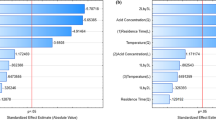Abstract
In this study, the repeated-batch fermentation of liquefied cassava medium using the flocculent hybrid Saccharomyces cerevisiae CHFY0321 was investigated for semicontinuous, high-throughput production of bioethanol. Cassava medium was selected due to the industrial requirement for a cheap starchy substrate. Fermentations were performed by simultaneous saccharification and fermentation (SSF) with a set of ten batches successfully completing a series within the repeated fermentation process. In addition, pH of the culture medium was not controlled to simplify ethanol production for future use in industry. Optimal recycling volume was found to be 5%. Volumetric productivity, final ethanol concentration, and ethanol yield were measured at 3.34 g l−1 h−1, 84.5 g l−1, and 90.7%, respectively. Cell recycling (24.5 g DCW l−1) resulted in 1.8-fold decrease in fermentation time (24 h) and 1.8-fold increase in volumetric productivity compared with the ordinary batch fermentation. Therefore, repeated-batch SSF using flocculent CHFY0321 demonstrates the possibility of cost-effective bioethanol production by eliminating additional saccharification and inoculation steps.




Similar content being viewed by others
References
Amutha R, Gunasekaran P (2001) Production of ethanol from liquefied cassava starch using co-immobilized cells of Zymomonas mobilis and Saccharomyces diastaticus. J Biosci Bioeng 92:560–564
Bae SM, Park YC, Lee TH, Kweon DH, Choi JH, Kim SK, Ryu YW, Seo JH (2004) Production of xylitol by recombinant Saccharomyces cerevisiae containing xylose reductase gene in repeated fed-batch and cell recycle fermentations. Enzyme Microb Technol 35:545–549
Bai FW, Anderson WA, Moo-Young M (2008) Ethanol fermentation technologies from sugar and starch feedstocks. Biotechnol Adv 26:89–105
Bony M, Barre P, Blondin B (1998) Distribution of the flocculation protein, Flop, at the cell surface during yeast growth: the availability of Flop determines the flocculation level. Yeast 14:25–35
Cunha MAA, Rodrigues RCB, Santos JC, Converti A, da Silva SS (2007) Repeated-batch xylitol bioproduction using yeast cells entrapped in polyvinyl alcohol-hydrogel. Curr Microbiol 54:91–96
Devantier R, Pedersen S, Olsson L (2005) Characterization of very high gravity ethanol fermentation of corn mash: effect of glucoamylase dosage, pre-saccharification and yeast strain. Appl Microbiol Biotechnol 68:622–629
Hahn-Hagerdal B, Galbe M, Gorwa-Grauslund MF, Liden G, Zacchi G (2006) Bio- ethanol-the fuel of tomorrow from the residues of today. TRENDS Biotechnol 24:549–556
Hahn-Hagerdal B, Karhumaa K, Fonseca C, Spencer-Martins I, Gorwa-Grauslund MF (2007) Towards industrial pentose-fermenting yeast strains. Appl Microbiol Biotechnol 74:937–953
Horiuchi JI, Yamauchi N, Osugi M, Kannao T, Kobayashi M, Kuriyama H (2000) Onion alcohol production by repeated batch process using a flocculating yeast. Bioresource Technol 75:153–156
Horn SJ, Aasen IM, Ostgaard K (2000) Ethanol production from seaweed extract. J Ind Microbiol Biot 25:249–254
Hounsa CG (1998) Role of trehalose in survival of Saccharomyces cerevisiae under osmotic stress. Microbiology 144:671–680
Hu CK, Bai FW, An LJ (2005) Effect of the flocculating of a self-flocculating yeast on its ethanol tolerance and corresponding mechanisms. Chin J Biotechnol 21:123–128
Hu Z, Tan P, Pu G (2006) Multi-objective optimization of cassava-based fuel ethanol used as an alternative automotive fuel in Guangxi, China. Appl Energ 83:819–840
Jin YL, Speers A (2000) Effect of environmental conditions on the flocculation of Saccharomyces cerevisiae. J Am Soc Brew Chem 58:108–116
Jirku V (1999) Whole cell immobilization as a means of enhancing ethanol tolerance. J Ind Microbiol Biotechnol 22:147–151
Kida K, Morimura S, Kume K, Suruga K, Sonoda Y (1991) Repeated batch ethanol fermentation by a flocculating yeast Saccharomyces cerevisiae IR-2. J Fermet Bioeng 71:340–344
Kida K, Kume K, Morimura S, Sonoda Y (1992) Repeated-batch fermentation process using a thermotolerant flocculationg yeast constructed by protoplast fusion. J Ferment Bioeng 74:169–173
Kuriyama H, Seiko Y, Murakami T, Kobayashi H, Sonda Y (1985) Continuous ethanol fermentation with cell recycling using flocculating yeast. J Ferment Technol 63:159–165
Margaritis A, Bajpai P (1981) Repeated batch production of ethanol from Jerusalem artichoke tubers using recycled immobilized cells of Kluyveromyces fragilis. Biotechnol Lett 3:679–682
Novozymes (2004) Application sheet: Enzymes that make glucose from liquefied grains. Novozymes, Bagsvaerd
RFA—Renewable Fuels Association (2008) http://www.ethanolrfa.org/ (accessed 29.02.08)
Rubo L, Wang C, Zhang C, Dai D, Pu G (2008) Life cycle inventory and energy analysis of cassava-based fuel ethanol in China. J Clean Prod 16:374–384
Sakurai A, Nishida Y, Saito H, Sakakibara M (2000) Ethanol production by repeated batch culture using yeast cells immobilized within porous cellulose carriers. J Biosci Bioeng 90(5):526–529
Sassner P, Galbe M, Zacchi G (2008) Techno-economic evaluation of bioethanol production from three different lignocellulosic materials. Biomass Bioenerg 32:422–430
Seong KT, Katakura Y, Ninomiya K, Bito Y, Katahira S, Kondo A, Ueda M, Shioya S (2006) Effect of flocculation on performance of arming yeast in direct ethanol fermentation. Appl Microbiol Biotechnol 73:60–6
Soares EV, Texeira JA, Mota M (1994) Effect of cultural and nutritional conditions on the control of flocculation expression in Saccharomyces cerevisiae. Can J Microbiol 40:851–857
Thatipamala R (1992) Effect of high product and substrate inhibitions on the kinetics and biomass and product yields during ethanol batch fermentation. Biotechnol Bioeng 40:289–297
Author information
Authors and Affiliations
Corresponding author
Rights and permissions
About this article
Cite this article
Choi, GW., Kang, HW. & Moon, SK. Repeated-batch fermentation using flocculent hybrid, Saccharomyces cerevisiae CHFY0321 for efficient production of bioethanol. Appl Microbiol Biotechnol 84, 261–269 (2009). https://doi.org/10.1007/s00253-009-1946-3
Received:
Revised:
Accepted:
Published:
Issue Date:
DOI: https://doi.org/10.1007/s00253-009-1946-3




